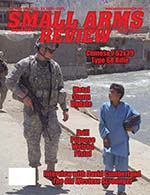Review by Chuck Madurski
Air Machine Guns
By Larry Behling
Available from the author at
220 County Route 6
Phoenix, NY 13135
Or email: rte6larry@alltel.net
$65.00 plus $8.40 shipping
For many folks, their first exposure to automatic arms was, as often as not, standing at a booth at a carnival or fair. Indeed, this is quite often their only interaction with machine guns. Commonly, the game of shooting the star out was overshadowed by the thrill and excitement of shooting a fully automatic weapon - even if it was powered by air. In Air Machine Guns, Larry Behling helps the reader relive those times, and along the way provides stories and information about several other air powered machine guns.
The book is set up somewhat chronologically. One of the first guns detailed is a 24 pound Browning water cooled replica that was part of the attractions at Coney Island. A large format like this book has lots of room for generous numbers of outsized and detailed photographs, which the author has made good use of. Surprisingly, one of the photos in this section on the Browning replica shows what looks, initially, to be an AR type rifle front sight base. Instead, the item in question is a mounting interface for the air machine gun.
Covered in similar fashion are the air machine guns used for training purposes during WWII. Among the more noteworthy are Ma Deuce (M2) look-a-likes made by General Electric and Hotpoint. As a training tool, these guns provided invaluable service until production of the real thing (and ammo) caught up to demand. One of the tricks used to speed the assimilation of gunnery skills was the use of white colored pellets in daytime and red ones under ultraviolet light to simulate tracer fire at night.
The most common type of air machine gun is the previously mentioned variety used at fairs and carnivals to shoot a paper target with a red star on it or some other target. Completely removing the star from the target wins a prize, and as many found out, was much more difficult that it looked. These guns generally resembled a Thompson submachine gun and were typically tethered to the counter. Several companies manufactured these guns, and they are well covered by Behling, including tracking the somewhat convoluted history of the multiple entities that succeeded the prior, failed concerns. Included among the companies that made this type of gun are Feltman, The Shooting Star Company and Vintage Pneumatics, among others. While many of these are gone now, Shooting Star lives on as Shooting Star, Inc. Centered in New Jersey, they continue to make and service the legendary BB machine gun, along with the fun Shooting Waters game wherein the players shoot a stream of water into a clown’s mouth in order to inflate a balloon to be the first to pop it.
Another fantastic gun covered nicely is the Caselman. Available in larger calibers like .30, 9mm and .45, it is one of the most powerful air machine guns with maximum muzzle energy of over 300 foot-pounds. Like most of the guns in the book, these are not toys, and costs are commensurate ranging from $2,500 to $4,000.
Numerous other modern guns are covered in varying displays of detail and photographic excellence. The recent Internet sensation, the Russian Drozd is there, so is an AR-15 look-a-like originally from New Matics, shown in the book as being built by FN in South Carolina. For the exotic lovers, Piper’s Gatlings (miniguns) are well represented too. Some of these are nothing short of fantastic with ammo capacities of 2,400, rates of fire over 1,000 rpm and such refinements as rifled barrels.
For most, this book’s most important guns are the shoot-out-the-star types. But for those of a certain age, the one that thrilled with its advertisements for over half a generation is the wonderfully named M19-A Annihilator! Who can forget those advertisements in all of the gun magazines in the 1980s and early 1990s? That steel pot wearing guy, widely grinning with the cigar stuck in the corner of his mouth. Even the gun itself had styling to go along with the image, looking (very) vaguely like the M3 Grease Gun.
One especially interesting feature included in several places are photographic reproductions of receipts, instructions and other factory, sales or advertising documents related to the guns being detailed: a nice touch and a look at how things often used to be done.
This book deals with the entertainment inspired machine gun as well as the military training models in equal fashion and gives proper perspective to both. For the collector, shooter, and historian or just for reminiscing on a rainy afternoon, Air Machine Guns is a well written book with lots of pictures that should appeal to a wide audience. As mentioned earlier, it is a large format book with 324 pages, tape bound and soft cover. Now excuse me as I go kick my Red Ryder...
This article first appeared in Small Arms Review V12N11 (August 2009) |
| SUBSCRIBER COMMENT AREA |
Comments have not been generated for this article.




